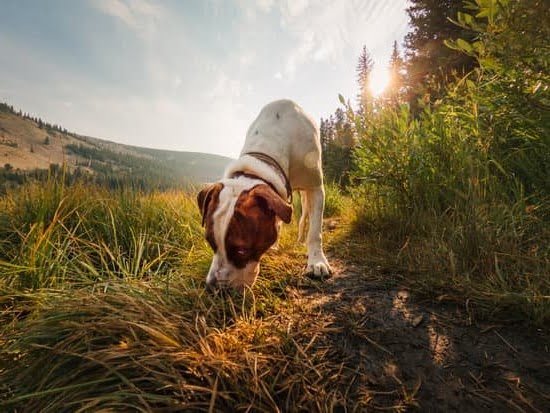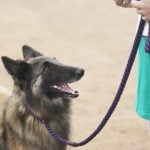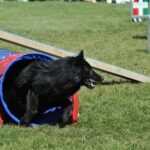House training a 1-year-old dog can be a daunting task for many pet owners. The idea of teaching an older dog new tricks, especially when it comes to bathroom habits, may seem overwhelming at first.
However, with the right approach and a little bit of patience, house training can be successfully achieved. This article will explore the challenges and misconceptions surrounding house training older dogs, highlighting the importance of consistency, positive reinforcement, and understanding the dog’s background and habits.
When it comes to house training a 1-year-old dog, one of the main challenges is breaking past any preconceived notions that they are too old to learn or change their behaviors. While it is true that younger puppies have an easier time grasping new concepts, older dogs can still be effectively trained with the right techniques.
It is crucial to understand that accidents during the house training process are not a sign of failure but rather part of the learning curve.
Patience is key when it comes to house training an older dog. It may take more time for them to unlearn previous habits or establish new ones. Consistency in commands, rewards, and routines plays a significant role in helping the dog understand what is expected of them.
Positive reinforcement through praise and treats helps motivate the dog towards desired behavior. By acknowledging their progress and providing them with incentives for doing well, owners can create a positive association with house training.
Understanding the Basics
House training a 1-year-old dog can be challenging, but with the right understanding of basic principles, it is definitely achievable. The foundational concepts of house training involve establishing a routine and supervising the dog, along with the use of positive reinforcement and rewards.
Establishing a routine is crucial in house training a dog of any age. Dogs thrive on consistency and having a structured schedule helps them understand when they should eliminate outside. This involves feeding your dog at the same times every day, taking them out for bathroom breaks at regular intervals, and providing playtimes and walks at predictable hours.
Supervision is another important principle in house training. Keeping a close eye on your dog allows you to anticipate their needs and prevent accidents inside the house. When you cannot directly supervise your dog, confine them to one area or crate them to prevent accidents while you are away.
Positive reinforcement and rewards play a vital role in reinforcing desired behaviors during house training. When your dog eliminates outside, praise them enthusiastically and give them treats to create positive associations with going potty in the appropriate place. Consistency is key when using rewards – make sure to give treats immediately after they eliminate outside so they understand what behavior is being rewarded.
In summary, understanding these fundamental principles of house training will set you on the path to success when training your 1-year-old dog. Establishing a routine, supervising your dog effectively, and using positive reinforcement will expedite the process of teaching your furry friend where it is appropriate to go potty. With patience and consistency, you can achieve successful house training with your older pup.
| Principles | Description |
|---|---|
| Establishing a routine | Feeding, bathroom breaks, playtimes at regular intervals |
| Supervision | Anticipate needs, prevent accidents by confining or crating when necessary |
| Positive reinforcement and rewards | Praise and treats for eliminating outside, create positive associations |
Assessing the Dog’s Background and Habits
When it comes to house training a 1-year-old dog, understanding the dog’s background and habits is an essential step in achieving success. Every dog comes with their own unique set of experiences and behaviors that can greatly impact their ability to be house trained. By taking the time to assess their past and current habits, you can better tailor your approach to address any specific challenges or triggers they may have.
Understanding the dog’s past experiences is crucial because it can offer insight into any possible reasons for their lack of house training. For example, if a dog was previously kept in unsanitary conditions or was subjected to punishment for eliminating indoors, they may have learned that going outside is not desirable or safe.
On the other hand, if a dog has always been allowed to eliminate anywhere they please without consequences, they may simply not understand the concept of being house trained.
To assess the dog’s habits effectively, keep a journal or log of when and where they tend to eliminate. Look for patterns or triggers that may be influencing their behavior.
Take note of factors such as time of day, location, or any specific circumstances that could be associated with their elimination needs. For instance, if you notice that your dog consistently eliminates after playing vigorously or shortly after eating, this can help you anticipate when they are more likely to need a bathroom break.
Taking the time to understand your 1-year-old dog’s background and habits will provide valuable insights into their house training needs. By tailoring your approach based on these observations, you can increase the chances of successful training and minimize setbacks along the way.
Identifying Patterns
One way to identify patterns in your dog’s elimination needs is by establishing a consistent routine for observation. Pay attention to when they tend to eliminate throughout the day and whether they display any cues signaling their need to go outside such as sniffing or circling. By consistently observing and noting their behavior, you can gradually develop a better understanding of their elimination patterns.
Recognizing Triggers
In addition to identifying patterns, recognizing triggers for your dog’s elimination needs is equally important. Triggers can be specific events or activities that prompt your dog to feel the need to eliminate. Common triggers include waking up in the morning, after meals, after play sessions, or when they are excited or anxious. By identifying these triggers, you can anticipate when your dog is more likely to need a bathroom break and take them outside accordingly.
Adjusting Expectations
Understanding your dog’s background and habits also means adjusting your expectations during the house training process. Keep in mind that it may take longer for an older dog with ingrained behaviors to become fully house trained compared to a younger puppy. Be patient with your furry friend and celebrate small victories along the way. With consistent effort and the right approach tailored to their needs, you can help your 1-year-old dog successfully become house trained.
Creating a Structured Routine
One of the most crucial steps in house training a 1-year-old dog is to establish a structured routine. Dogs thrive on consistency and predictability, so having a set schedule for feeding, playtime, and bathroom breaks can greatly aid in the house training process.
To create an effective routine, start by determining the appropriate intervals for your dog’s meals and bathroom breaks. Most adult dogs need to go outside to eliminate about 4-6 times a day. Consider your dog’s size, breed, and activity level when establishing these intervals. For example, smaller breeds may require more frequent potty breaks compared to larger breeds.
In addition to regular bathroom breaks, make sure to incorporate daily exercise and mental stimulation into your dog’s routine. A tired dog is less likely to have accidents indoors. Take your furry friend for walks or engage in active play sessions to burn off excess energy. Puzzle toys and training sessions are also excellent ways to keep their minds occupied.
Consistency is key when implementing a structured routine. Try your best to stick to the established schedule as closely as possible every day. Pick specific times for feeding and take your dog outside immediately after each meal. Gradually reduce the frequency of bathroom breaks as your dog becomes more reliable in holding their bladder.
Remember that accidents may still happen during the initial stages of house training. If you catch your dog about to eliminate indoors or find evidence of an accident, do not scold or punish them retroactively. This will only confuse them and hinder the training process. Instead, calmly interrupt them by saying “no” or clapping your hands and quickly take them outside to finish eliminating in their designated spot.
By creating a consistent routine with regular feeding times, bathroom breaks, exercise, and mental stimulation, you are setting your 1-year-old dog up for success in their house training journey. Stay patient and persistent throughout this process as it may take some time for your dog to fully grasp the routine and understand where they should eliminate. Remember, establishing a structured routine is a foundation for successful house training.
Establishing the Right Environment for Success
The Importance of a Comfortable and Safe Space
When it comes to house training a 1-year-old dog, creating the right environment plays a crucial role in their success. Providing a comfortable and safe space for your dog will not only make them feel secure but also help them establish good bathroom habits.
One essential aspect is ensuring that your dog has a designated area where they can go to eliminate, such as a specific spot in your yard or an indoor pee pad. This helps them associate that location with the proper place to relieve themselves.
Inside your home, set up a confined area for your dog when you are unable to supervise them closely. This could be an exercise pen or crate. Using baby gates to limit access to certain areas of the house can also be helpful in preventing accidents. It’s important that this space is large enough for your dog to move around comfortably, but not too big where they have ample room to eliminate away from their designated spot.
Remember to also consider any potential hazards within their environment. Remove any toxic plants, chemicals, or objects that can be harmful if chewed on or ingested. Ensure that electrical cords are inaccessible and loose items are safely stowed away so they cannot become choking hazards.
Addressing Potential Confinement Issues
Confining your dog during the house training process may seem challenging at first, as dogs generally prefer not to eliminate in their living spaces. However, there are effective strategies to address this issue and prevent anxiety or discomfort for your furry friend.
One method is gradually increasing the amount of freedom your dog has over time as they consistently demonstrate good bathroom habits. Start by confining them to a small area using an exercise pen or crate where they have access to their designated elimination spot (whether it’s outside or an indoor pee pad). As they consistently use this area for eliminating, gradually expand their confinement area until they have access to the entire house.
Another approach is utilizing a crate. Dogs have a natural instinct to keep their sleeping area clean, so crates can be invaluable tools for house training. Introduce your dog to the crate gradually, allowing them to associate it with positive experiences such as treats or meals. Use the crate only when necessary, such as during times when you cannot directly supervise your dog or at night while you sleep.
Effective Solutions for Confinement Issues
Some dogs may initially resist being confined or display signs of anxiety or distress when being separated from their owners. In these situations, it’s essential to address the confinement issues and help your dog feel more comfortable.
You can implement gradual desensitization by starting with short periods of confinement and gradually increasing the duration over time. Provide engaging toys or puzzle feeders in their confined area to help distract and stimulate their minds, making the experience more enjoyable.
Additionally, ensure that your dog receives plenty of physical exercise and mental stimulation throughout the day. A tired dog is less likely to become restless or anxious when confined. Engage in regular play sessions, interactive games, and challenging activities that mentally tire out your furry friend.
By taking these measures and establishing the right environment for success, you are setting both yourself and your 1-year-old dog up for a smoother house training journey. Remember, patience is key as every individual dog learns at their own pace. With consistency and positive reinforcement, you’ll soon see progress and enjoy the benefits of having a well-house trained companion.
Effective Training Techniques for Housebreaking
Housebreaking is an essential aspect of house training a 1-year-old dog. There are several effective training techniques that can be used to teach a dog where it is appropriate to eliminate. It is important to note that different techniques may work better for different dogs, so it may be necessary to try different methods to find the most suitable one for your dog.
One popular technique for housebreaking is crate training. This involves confining your dog in a crate when you are unable to supervise them, such as during the night or when you are away from home. Dogs naturally do not like soiling their sleeping area, so they will learn to hold their bladder and bowels while in the crate.
Make sure the crate is appropriately sized, with enough room for them to stand up, turn around, and lie down comfortably. Take your dog immediately outside to their designated bathroom area as soon as you let them out of the crate.
Another technique that can be used alongside or instead of crate training is using puppy pads. Puppy pads are absorbent mats that can be placed in a specific area indoors where you want your dog to eliminate. When your dog uses the pad correctly, reward them with praise and treats. Over time, gradually move the puppy pad closer to the door leading outside until it is eventually placed outside in the desired bathroom area.
Using a designated outdoor area for elimination can also be an effective training technique. Take your dog outside frequently throughout the day, especially after meals, playtime, and waking up from naps. Choose a specific spot in your yard where you want them to eliminate and use cues such as “go potty” or “do your business” consistently every time they go outside. Reward them with praise and treats immediately after they have finished eliminating in the correct spot.
It is important to note that regardless of which technique you choose, accidents will happen during the house training process. When accidents occur, it is crucial to clean up the mess using an enzymatic cleaner designed to eliminate the odor. Avoid punishing your dog for accidents, as this can create fear and anxiety around elimination. Instead, focus on reinforcing positive behaviors by rewarding your dog when they eliminate in the appropriate location.
By employing effective training techniques such as crate training, using puppy pads, or establishing a designated outdoor area, you can successfully housebreak your 1-year-old dog. Consistency and patience are key throughout this process, so be prepared for setbacks and stay motivated. With time and dedication, you will help your dog develop good elimination habits and create a well-trained and happy household companion.
Troubleshooting Common Challenges
House training a 1-year-old dog can come with its fair share of challenges. However, with patience and perseverance, these challenges can be overcome. In this section, we will discuss some common difficulties that may arise during the house training process and offer practical solutions to help you navigate through them.
- Accidents: Accidents can happen even during the house training process. It’s important not to scold or punish your dog when accidents occur, as this may lead to fear and confusion. Instead, focus on reinforcing positive behavior through rewards and praise when your dog eliminates in the appropriate spot. If accidents happen indoors, clean the area thoroughly with an enzymatic cleaner to remove any lingering odor that may attract your dog back to the same spot.
- Marking: Marking is a behavior where dogs urinate small amounts on vertical surfaces to mark their territory. This behavior can be challenging to deal with during house training. To address marking, ensure that your dog receives plenty of exercise and mental stimulation throughout the day to help reduce this behavior. Additionally, consider using belly bands or diapers specifically designed for dogs who have difficulty controlling their bladder.
- Resistance to Training: Some dogs may show resistance or stubbornness during the house training process. Remember that consistency is key – stick to your established routine and continue using positive reinforcement techniques consistently. If you encounter resistance, it may be helpful to consult a professional trainer who specializes in positive reinforcement methods to guide you through any roadblocks.
By troubleshooting these common challenges effectively and remaining patient, you can overcome them and continue progressing in the house training journey with your 1-year-old dog. Remember that every dog is unique, so it may take time to find what works best for yours.
For more specific guidance tailored to your individual circumstances or if you’re facing unique challenges not covered here, consider reaching out to a professional dog trainer or animal behaviorist who can provide personalized advice and support.
The Role of Consistency and Patience
Consistency and patience are two crucial factors in successfully house training a 1-year-old dog. While it may be tempting to become frustrated or give up when faced with setbacks or accidents, it is important to remain consistent in your approach and patient with the process. This section will delve into the significance of consistency and patience, providing guidance on how to maintain these qualities throughout the house training journey.
Consistency is key when it comes to house training a 1-year-old dog. Dogs thrive on routine, so establishing a consistent schedule for feeding, playtime, and bathroom breaks is essential. When you feed your dog at the same times each day, their elimination patterns become more predictable, making it easier for you to anticipate when they will need to go outside. Similarly, maintaining a consistent bathroom break schedule ensures that your dog has regular opportunities to relieve themselves outdoors.
Consistency also extends to commands and rewards. It is important to use the same verbal cues and gestures consistently when instructing your dog during house training. This helps them develop a clear understanding of what is expected of them. Additionally, using consistent rewards such as praise or treats reinforces positive behavior and motivates your dog to continue following your instructions.
Patience is equally vital in the house training process. Remember that every dog learns at their own pace and may require different amounts of time to grasp certain concepts. Avoid getting frustrated or angry if accidents happen or if progress seems slow. Instead, take a deep breath and remind yourself that patience is necessary for effective communication with your furry companion.
It can also be helpful to adjust your expectations and celebrate small victories along the way. Recognize and reward your dog’s progress, no matter how small it may seem. This positive reinforcement encourages continued learning and reinforces good habits.
In summary, consistency and patience are indispensable when house training a 1-year-old dog. Maintaining a consistent routine provides structure and predictability for both you and your furry friend. Remaining patient throughout the process helps foster a positive and supportive training environment. With time, dedication, and a consistent and patient approach, you can successfully house train your 1-year-old dog.
Expert Tips and Success Stories
When it comes to house training a 1-year-old dog, learning from experts and hearing success stories can be incredibly helpful and inspiring. Professional trainers and experienced dog owners have valuable insights and techniques that can make the process more effective and enjoyable. Here are some expert tips and success stories to guide you on your journey of house training your older dog.
One important tip from trainers is to focus on positive reinforcement. Dogs respond best to rewards rather than punishment, so praise and treats can go a long way in encouraging desired behaviors.
Consistency is key when using positive reinforcement, as the dog needs to understand that they are being rewarded for eliminating outside or on their designated spot. Additionally, trainers recommend using a consistent cue word or phrase during bathroom breaks, which helps the dog associate the command with the action.
Another useful tip is to gradually increase the space available to your dog as they become more reliable with their bathroom habits. Starting with a smaller confined area such as a crate or playpen can help prevent accidents while teaching your dog how to hold their bladder for longer periods of time. As they demonstrate consistent bathroom habits, you can slowly expand their access to different rooms in your home.
Success stories from other dog owners also offer valuable insight into what has worked for them. For example, some owners found success by implementing a strict routine right from the start, including feeding times, exercise schedules, and designated potty breaks. Others emphasized creating a comfortable space for their dogs indoors that mimicked an outdoor environment, such as using artificial turf or puppy pads placed in a specific area.
In one heartwarming success story, Sarah shared her experience of house training her 1-year-old rescue dog named Cooper. Sarah took the time to understand Cooper’s past experiences and identified patterns in his behavior that indicated when he needed to eliminate.
By being consistent with potty breaks and rewarding Cooper every time he did his business outside, Sarah was able to successfully house train Cooper within a few weeks. Today, Cooper is a happy and confident dog who knows the importance of staying clean indoors.
By incorporating expert tips and learning from success stories like Sarah’s, you can navigate the challenges of house training a 1-year-old dog with increased confidence and understanding. Remember that every dog is unique, so it may take some trial and error to find the most effective approach for your furry friend. With patience, consistency, and the right techniques, you too can achieve success in house training your older dog.
Conclusion
In conclusion, house training a 1-year-old dog may present its challenges, but it is definitely a rewarding journey for both the dog and the owner. Throughout this article, we have explored the difficulties and misconceptions surrounding house training an older dog and highlighted the importance of patience, consistency, and positive reinforcement.
Understanding the basics of house training principles is crucial in order to establish a successful training routine. By establishing a routine and supervising the dog closely, we can effectively communicate our expectations and help them understand where they should eliminate. Positive reinforcement and the use of rewards play a vital role in motivating the dog to learn desired behaviors and reinforcing their progress.
Assessing the dog’s background and habits is also important in tailoring our approach to their specific needs. Identifying patterns and triggers related to their elimination needs can help us predict when they need to go outside or use their designated area indoors.
Creating a structured routine that includes regular feeding times, playtime, bathroom breaks, exercise, and mental stimulation is key in setting up our dogs for success. A structured routine provides them with stability and helps them develop good habits.
Establishing the right environment for success involves providing our dogs with a comfortable space that meets their needs while addressing any potential issues related to confinement. By creating a safe environment where they feel secure, we can prevent accidents or unwanted behaviors.
Effective training techniques are varied but selecting the most suitable method depends on factors such as the individual dog’s personality, preferences, and previous experiences. Whether it’s crate training, using puppy pads or designating an outdoor area, consistency is crucial to ensure their understanding of desired behaviors.
Troubleshooting common challenges is an inevitable part of house training any dog no matter their age. Accidents may happen occasionally or resistance to training might occur initially. However, it’s important not to get discouraged as setbacks are common during this process. By remaining patient and consistent with commands, rewards, and training methods, we can overcome these challenges and continue making progress.
Throughout this article, we have shared tips from professional trainers and success stories of older dogs who have successfully been house trained. These insights serve to remind us that with dedication, patience, and the right approach, house training a 1-year-old dog is indeed achievable.
So if you find yourself facing the task of house training your 1-year-old dog, take heart in knowing that it may require some time and effort, but the reward of a well-behaved and happy companion is well worth it.
Frequently Asked Questions
Is it too late to potty train a 1 year old dog?
It is not too late to potty train a 1-year-old dog, but it may require more time and patience compared to training a younger puppy. At this age, the dog likely has more control over their bladder and bowel movements, making it easier for them to learn the appropriate behavior. Consistency is key in potty training any dog, regardless of their age.
Set up a regular schedule for taking them outside to eliminate and reward them when they do so in the correct spot. Using positive reinforcement techniques and being diligent with supervision can help successfully potty train a 1-year-old dog.
Can a 1 year old puppy be potty trained?
Yes, a 1-year-old puppy can definitely be potty trained. While it is ideal to start the training process at a younger age, it is still possible to teach a 1-year-old pup where and when they should go potty. The basic principles of potty training remain the same regardless of the age of the dog: consistency, positive reinforcement, and setting up a routine.
Keep in mind that each dog learns at their own pace, so it’s important to be patient and understanding throughout the process. With time and dedication, most 1-year-old puppies can be successfully potty trained.
Why is my 1 year old dog not house trained?
There could be several reasons why your 1-year-old dog is not yet house trained. It’s important to rule out any underlying medical conditions that may contribute to frequent accidents by consulting with your veterinarian. In some cases, dogs may have developed bad habits or inconsistent routines due to previous living situations or lack of proper training early on in life.
Dogs also need clear communication from their owners about what behavior is expected from them when it comes to going potty indoors or outdoors. Make sure you are providing enough opportunities for your dog to eliminate outside and rewarding them appropriately for doing so correctly. With consistent training and patience, most 1-year-old dogs can still be successfully house trained.

Welcome to the blog! I am a professional dog trainer and have been working with dogs for many years. In this blog, I will be discussing various topics related to dog training, including tips, tricks, and advice. I hope you find this information helpful and informative. Thanks for reading!





